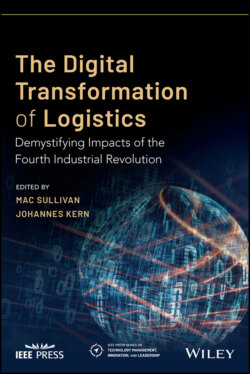Читать книгу The Digital Transformation of Logistics - Группа авторов - Страница 53
Get Decisions
ОглавлениеFrom a logistics management point of view, one major purpose of connecting Things and transferring, handling, and storing data in the IoT is to get decisions in a better (time, cost, quality) way than before. In general, we can separate into three different types of decision making: manual, automated, or autonomous.
In the manual decision way, the collected data is analyzed or displayed by certain applications that help the decision maker to come to better decisions. The decision itself remains a task of the related person. For example, in a transport company, based on GPS tracking, all trucks are displayed on a screen showing the map of the road combined with traffic and weather information. In the case of a certain event such as a traffic jam, the “decider” must decide where and how to intervene to keep promised lead times.
In case the decision process can be described in a standardized way, automated solution finding and decision making can be possible. Based on predefined checking and decision finding processes, the “application” (App) in use executes automatically the predefined solution process or gives a proposal to a human decider. Logistics management has to think about which kind of decision situations (e.g. data given by a Thing) can occur in which process and how the decision processes can be defined in a standardized way, including standardized answers. This is also discussed in Chapter 5.
The next level of decision making is currently in development using AI. Such AI systems can autonomously find solutions and come to decisions. Using big data and a self‐learning mode, the “machine” or application itself is smart enough to decide what to do next at a much higher speed and accuracy than humans. Logistics management has to determine which type of decision making is appropriate for which process based on which data from which Thing. Regardless of which type of decision making is applied, the analytics of the data as an input for the decision making can be done in mainly four different ways: descriptive, diagnostic, predictive, or prescriptive Figure 3.3 (Porter and Heppelmann 2015).
In a descriptive way, all selected information is gathered, and the monitored situation is described (e.g. condition, environment, process). Using the diagnostic way, the root causes of deviations between the set target value and the actual monitored value are analyzed. Hence, both the descriptive and diagnostic ways of analytics look back and explain what happened in the past. In a predictive way, the analyzed data is used to detect indications that signal impending events in the future. For example, if the system shows a certain number of Things in the inbound area of a warehouse while in parallel the internal data indicates that several workers are ill, it will most likely result in a delay or congestion in the goods receiving process – if no actions are taken. Lastly, the prescriptive form of data analytics strives for identifying measures to improve results or correct errors.
Figure 3.3 Get decisions.
Different applications need different ways of conducting data analytics. What they all have in common is that they get the data out of the pooled data location. In the first part of this chapter, we have discussed how the data get into the data lake and how to get improved decisions out of it. In the section that follows, we will discuss what needs to be considered to get prepared for logistics management in an IoT world.
